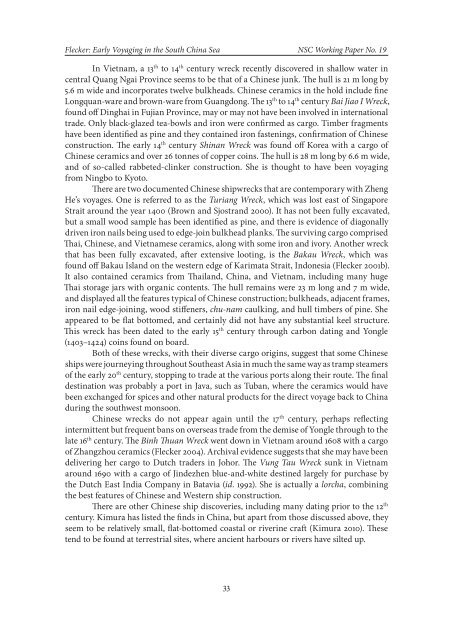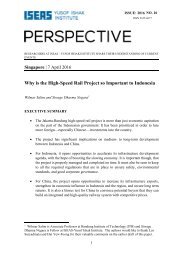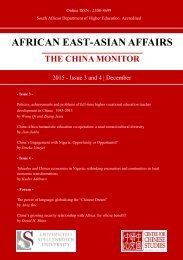NO.19
nscwps19_early_voyaging_south_china_sea_implications_territorial_claims
nscwps19_early_voyaging_south_china_sea_implications_territorial_claims
Create successful ePaper yourself
Turn your PDF publications into a flip-book with our unique Google optimized e-Paper software.
Flecker: Early Voyaging in the South China Sea NSC Working Paper No. 19In Vietnam, a 13 th to 14 th century wreck recently discovered in shallow water incentral Quang Ngai Province seems to be that of a Chinese junk. The hull is 21 m long by5.6 m wide and incorporates twelve bulkheads. Chinese ceramics in the hold include fineLongquan-ware and brown-ware from Guangdong. The 13 th to 14 th century Bai Jiao I Wreck,found off Dinghai in Fujian Province, may or may not have been involved in internationaltrade. Only black-glazed tea-bowls and iron were confirmed as cargo. Timber fragmentshave been identified as pine and they contained iron fastenings, confirmation of Chineseconstruction. The early 14 th century Shinan Wreck was found off Korea with a cargo ofChinese ceramics and over 26 tonnes of copper coins. The hull is 28 m long by 6.6 m wide,and of so-called rabbeted-clinker construction. She is thought to have been voyagingfrom Ningbo to Kyoto.There are two documented Chinese shipwrecks that are contemporary with ZhengHe’s voyages. One is referred to as the Turiang Wreck, which was lost east of SingaporeStrait around the year 1400 (Brown and Sjostrand 2000). It has not been fully excavated,but a small wood sample has been identified as pine, and there is evidence of diagonallydriven iron nails being used to edge-join bulkhead planks. The surviving cargo comprisedThai, Chinese, and Vietnamese ceramics, along with some iron and ivory. Another wreckthat has been fully excavated, after extensive looting, is the Bakau Wreck, which wasfound off Bakau Island on the western edge of Karimata Strait, Indonesia (Flecker 2001b).It also contained ceramics from Thailand, China, and Vietnam, including many hugeThai storage jars with organic contents. The hull remains were 23 m long and 7 m wide,and displayed all the features typical of Chinese construction; bulkheads, adjacent frames,iron nail edge-joining, wood stiffeners, chu-nam caulking, and hull timbers of pine. Sheappeared to be flat bottomed, and certainly did not have any substantial keel structure.This wreck has been dated to the early 15 th century through carbon dating and Yongle(1403–1424) coins found on board.Both of these wrecks, with their diverse cargo origins, suggest that some Chineseships were journeying throughout Southeast Asia in much the same way as tramp steamersof the early 20 th century, stopping to trade at the various ports along their route. The finaldestination was probably a port in Java, such as Tuban, where the ceramics would havebeen exchanged for spices and other natural products for the direct voyage back to Chinaduring the southwest monsoon.Chinese wrecks do not appear again until the 17 th century, perhaps reflectingintermittent but frequent bans on overseas trade from the demise of Yongle through to thelate 16 th century. The Binh Thuan Wreck went down in Vietnam around 1608 with a cargoof Zhangzhou ceramics (Flecker 2004). Archival evidence suggests that she may have beendelivering her cargo to Dutch traders in Johor. The Vung Tau Wreck sunk in Vietnamaround 1690 with a cargo of Jindezhen blue-and-white destined largely for purchase bythe Dutch East India Company in Batavia (id. 1992). She is actually a lorcha, combiningthe best features of Chinese and Western ship construction.There are other Chinese ship discoveries, including many dating prior to the 12 thcentury. Kimura has listed the finds in China, but apart from those discussed above, theyseem to be relatively small, flat-bottomed coastal or riverine craft (Kimura 2010). Thesetend to be found at terrestrial sites, where ancient harbours or rivers have silted up.33








